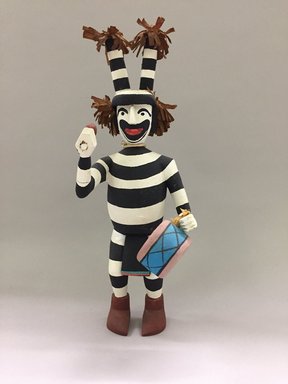
Artist:Hopi Pueblo
Medium: Wood (likely cottonwood), plant fibers, fabric, paint, cord
Geograhical Locations:
Dates:late 20th century
Dimensions: 15 × 5 1/4 × 7 in. (38.1 × 13.3 × 17.8 cm)
Collections:
Accession Number: 2013.64.11
Image: CUR.2013.64.11_front.jpg,
Catalogue Description: Koshare clown, striped black and white figure playing a drum while shaking a rattle.He wears leather boots.This sacred clown kachina is associated with fertility, rain, sun, corn and corn pollen, associations that give him power. He also plays a dual role of personifying supernatural spirits and society controller. By parodying the behavior of the audience he often involves them in laughter producing skits. Such theatrics have a serious side in that they demonstrate behavior that is unacceptable.No one, Hopi or non-Hopi in the audience is safe from their ridicule. In this way Koshares serve an important function as the keepers of societal behavior norms. Men who fulfill this role do not inherit the right nor are they appointed. Instead they choose it as an important vocation.